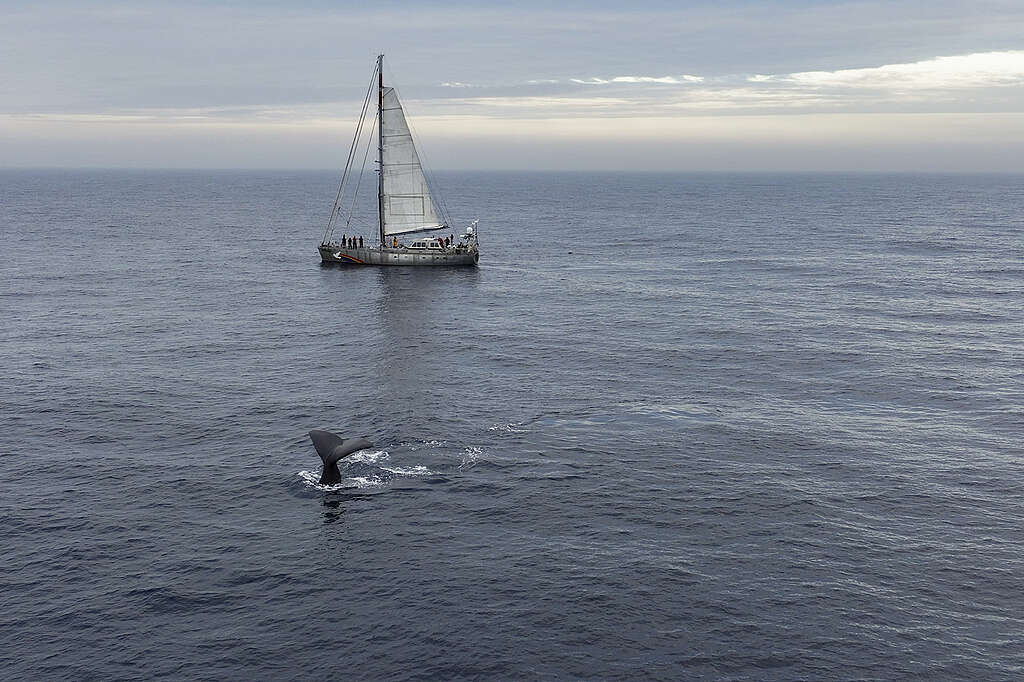In case you haven’t heard, the Norwegian government plans to open Arctic waters for deep-sea mining. And the spot they have in mind — an area located in the Norwegian Sea — is roughly the size of New Brunswick. The effect on wildlife will be devastating.
In response, Greenpeace has teamed up with scientists and campaigners and set sail to the proposed mining site on our vessel, The Witness.
Our mission: study the cetaceans — whale, dolphin and porpoise species — who will be directly threatened by the destructive impacts of this mining, broadcast our findings, and pressure the Norwegian government to ditch their plans.
The proposed mining area features underwater mountains and ridges, which are vital habitats for many marine species, including whales and dolphins, who rely on them for feeding, breeding, and navigation.
“Although it has long been known that whales and dolphins live in this area, we still know remarkably little about their abundance, distribution and behaviours, including how much they rely on healthy ecosystems around seamounts,” explains David Santillo, Senior Scientist at the Greenpeace Science Unit.
Yet Norwegian mining companies plan to extract mineral-rich crusts from these very seamounts, jeopardizing centuries-old ecosystems. They also intend to mine hydrothermal vents — openings in the seafloor that release heated mineral-rich water — which are essential for some deep-sea creatures.
Norway has already received significant international criticism, with over 800 marine scientists calling for a pause on deep-sea mining. So far, it’s been to no avail: the Norwegian government still seems willing to risk the health and stability of these fragile ecosystems in the interests of corporate profit.
“Norway’s plans not only directly threaten species and habitats on the seabed due to the mining machines, but also the wider marine ecosystem, from the tiniest plankton to the great whales,” explains Santillo.

© Christian Åslund / Greenpeace. The fluke of a sperm whale is spotted in front of Greenpeace’s sailing vessel, The Witness, during our Norwegian Deep-Sea Mining ship tour.
And while research is underway to understand the harms that will come from this new practice, we continue to discover new ways the deep-sea plays an important role for the entire planet. For example, a recent scientific study revealed that polymetallic nodules in the Clarion-Clipperton Zone — an area in the Pacific Ocean that is also a target for mining — could play a crucial role in oxygen production in the deep-sea.
“Our expedition onboard The Witness enables us to look and listen with minimum disturbance, and should help us fill some of those gaps in scientific knowledge at a time and in an area where no-one else is watching,” says Santillo.
So far we’ve found that the region is home to several groups of sperm whales, orcas, fin whales, dolphins, and minke whales, but there’s so much more to discover — and protect.
The Norwegian government’s push for mining, despite the lack of understanding of its impacts, is irresponsible. But there’s still time to prevent it, and we won’t stop advocating for our oceans — and all of their unique and vital ecosystems — until all governments sign a moratorium on deep-sea mining.
If you’d like to learn more about this expedition follow this link.




Discussion
Please also mention the impact of military action on the environment. For instance the blowing up of an underwater gas line, the ongoing wars that are INCREASING CLIMATE DAMAGE to a substantial degree. No one seems to be bringing this forward. I ask you to promote this idea of peaceful co-existence of humans, animals and our natural environment.
It’s time for the governments of the world to make sure any further infrastructure and development is eco sustainable.